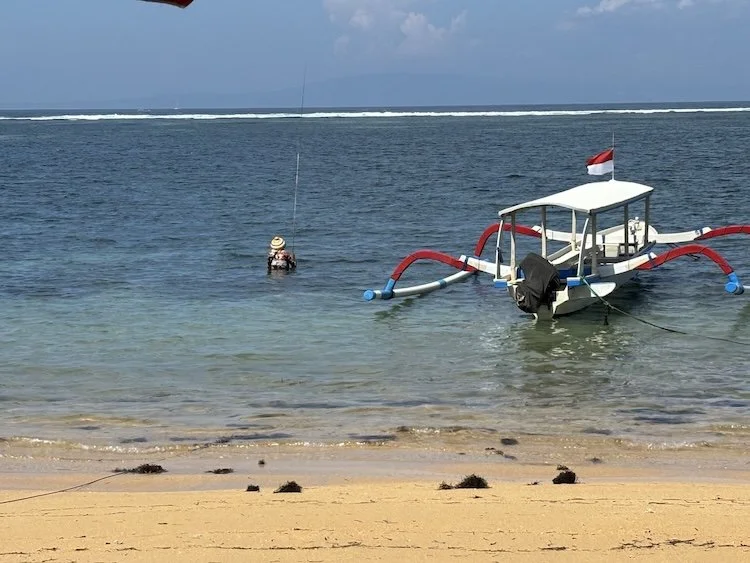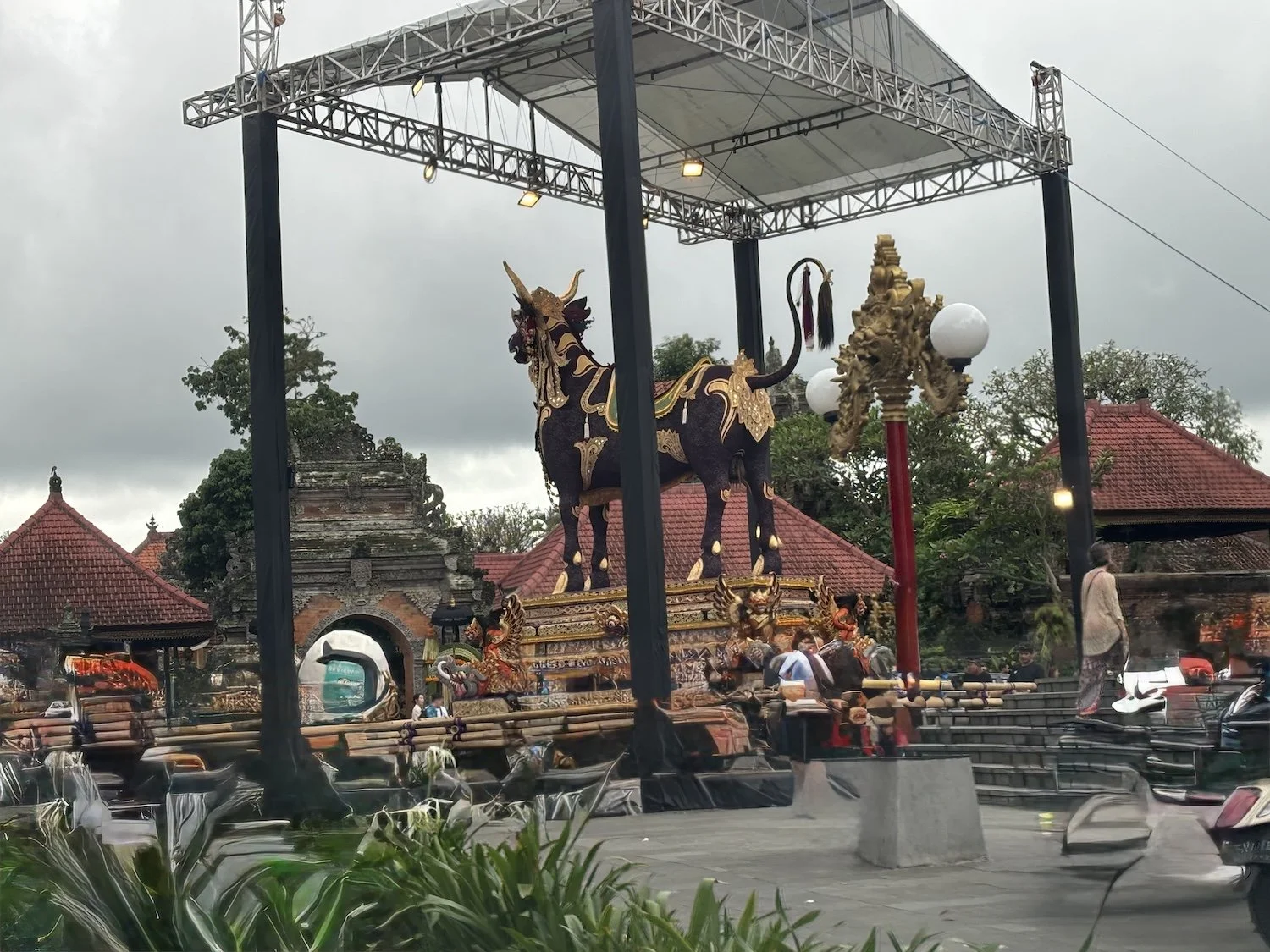
Slow Travel in Bali for Over 50s
Best Bases, Best Months, Best Moments
We do not come to Bali, Indonesia because of Eat Pray Love or some glossy yoga retreat brochure promising enlightenment with a side of green juice. We come for slow travel in Bali where nothing is rushed and for the rhythm of daily life that never makes it into guidebooks. Our days here are about watching Balinese life unfold. Slow, unhurried, and always surprising. Perfect for couples and travelers over 50 exploring Asia, seeking comfort, connection, and culture.
For mature slow travelers, this is the real draw. It is less about rushing through temples and more about sipping Bali coffee while the world hums by. It is wandering local markets, finding a favorite warung, and realizing that the best souvenir is knowing where the spiciest sambal hides.
Why Bali Works for Slow Travelers
Especially for Couples 50+
Temples and ceremonies are daily life. They often look like they should be charging admission. Incense pours over the altars, gongs pound in unison, and traditional clothes shimmer with bold color. It feels like theater, but no one is performing. This is the heart of Balinese culture and ceremonies, performed daily without tickets, hashtags, or irony.
Chaos rules the road. Scooters swarm like bees with a grudge. Then, two streets later, a rice field opens in calm defiance of the noise. Bali does not choose one world over the other. If you cannot, the island has a backup plan. Spas are more common than traffic lights. And for cheaper than the sandwich you regret buying at Gate 42, someone will twist, polish, and reset your body until you feel brand new.The kind of comfort slow traveling couples can actually afford to indulge in.
Finally, food in Bali does not whisper, it storms the stage. Sambal sneaks in like a prank and suddenly your mouth is on fire. Nasi campur changes with every warung, a surprise platter built around rice and whatever else the cook felt like that day. It is not a fixed recipe, it is a culinary mood swing that somehow leaves you grinning.
When the noise fades and the incense thins, what stays with us is not the sambal-induced tears or the sunsets that crash Instagram servers, but the way strangers smile like old friends. And welcome us as if we already belong
Best Areas to Stay in Bali for Slow Travel
Bali is not one-size-fits-all, though I once tried by booking a room beside a rice field and pretending the mosquito swarm was part of the spiritual detox. A week later I moved to a resort where silence was piped in along with the room service. Both were Bali, both were real, and both left me wondering which version I actually wanted to crawl out of bed into.
Denpasar
Bali’s capital is not built to impress. There are no infinity pools or floating breakfasts, just traffic, markets, and the rhythm of daily life. My favorite stop was Tiara Dewata, the neighborhood grocery store near where I stayed. Prices were good, but the real trap was the snack aisle. Every day there were trays of traditional treats, wrapped in banana leaves or glistening with coconut, changing often enough that I convinced myself it was research to try them all. Most visits ended with me walking out loaded like I was catering a wedding, when in reality it was just me and my questionable self-control.
Best for: Travelers who like their experiences unfiltered, with a side of sambal and street noise.
Kuta
Kuta is that friend who suggests tequila shots at noon. It is the original Bali party zone with hostels, surfboards, and bars that never close. We lasted one hour before Cary muttered, “This feels like a music festival that forgot to end,” and we escaped. If your idea of slow travel is a two-day hangover, Kuta will provide. For something quieter, you can duck into Starbucks Dewata, the largest Starbucks in Southeast Asia, which feels more like a coffee theme park than a café.
Best for: Backpackers, surfers, and night owls who thrive on neon.
Sanur
In Sanur the beach fills up early, not with partiers but with walkers who treat sunrise like a group appointment. By the time you wander in, half the town is already halfway to its step goal. The cafés along the beach and streets keep the whole thing moving with pastries and breakfasts, so the scene feels less like exercise and more like a progressive dinner that forgot to stop at night.
If you want to pair that laid-back rhythm with a touch of luxury, the Andaz Sanur Hotel sits right on the shoreline, offering calm beaches, shady gardens, and a resort atmosphere that still feels connected to the neighborhood’s easy pace.
Best for: Retirees, families, couples, and anyone who wants to sleep through the night.
Seminyak
Think of Seminyak as Kuta’s cousin who studied abroad and came back wearing linen. It is stylish, expensive, and self-aware. We tried a café where the avocado toast was served like modern art, balanced with edible flowers and a drizzle that looked too pretty to eat. Cary sighed, “Great, now my breakfast has more followers than I do.”
That is Seminyak, Bali polished up for the Instagram age. The traffic will test your patience, but the food scene makes up for it, and no one blinks if you order dessert before dinner.
Best for: Couples, food lovers, and anyone who thinks cocktails taste better with an ocean view.
Nusa Dua
Nusa Dua is Bali on mute, and that is exactly the point. The beaches are serene, the waves polite, and for once you can actually hear yourself think. One afternoon Cary and I sat on the sand for so long that a beach vendor finally stopped trying to sell us sarongs and instead asked if we were okay. We were not meditating, just perfecting the art of becoming beach furniture.
The hotels are pricey, yes, but the calm is worth it. Two or three days here feels like slipping into a spa ad. Stay longer and you start wondering if maybe you should be doing something besides collecting seashells and debating when to order another coconut.
Best for: Travelers seeking a serene, luxurious beach holiday, honeymooners, and families with kids looking for safe beaches, family-friendly resorts, and kid-focused amenities.
Ubud
Ubud is Bali’s cultural heart. It smells like incense, rain, and espresso, often all at once. Artists, healers, dancers, yogis, and rice farmers all seem to share the same rhythm here. We spent a month in Ubud and never got bored. Mornings meant ridge walks, afternoons meant ceremonies, and evenings meant the eternal argument: curry or duck. Even on quieter days there was always something to discover, such as the Ubud Mask and Puppet Museum where centuries of Balinese storytelling come to life in painted faces and shadow-play figures. If you want to slow down and stay put, Ubud is the place that lets you do both without guilt.
Best for: Couples, culture seekers, wellness travelers, and anyone who wants Bali beyond the beach
Slow Things to Do in Bali
Not every trip to Bali has to involve sunrise hikes or hanging off the side of a volcano. Slow travelers can soak in plenty of magic without ever breaking a sweat.
Temple time
Uluwatu Temple at Sunset.
The temple sits on a cliff so high above the Indian Ocean you wonder who approved the safety plan. The view is worth it, the kecak dance is unforgettable, and the monkeys run the place like a mafia. They steal sunglasses, snacks, and water bottles, then hang around waiting for you to negotiate their return with fruit. We saw one crack open a Coke like a seasoned thief. This was not its first heist.
Tirta Empul Water Temple
Balinese families step into the sacred pools for purification, splashing cold spring water over their heads with a devotion no tourist ritual could fake. Even if you stay dry, the place pulls you in. It is not a photo op. It is worship, and it feels like a privilege to witness.
Walks With a View
Campuhan Ridge, Ubud
The ridge is basically Bali showing off. Rice fields, rolling hills, and a path so ridiculously pretty you half expect it to start humming background music. It feels dreamy until about 9 a.m. when the sun cranks up and suddenly you are the rotisserie chicken. The fix is simple: go early. At dawn you get cool air, quiet skies, and a trail that feels secret—at least until the first wave of selfie sticks comes marching in.
Sanur Sunrise
Sanur skips the sunset chaos and shows up early instead. The boardwalk fills with walkers while fishing boats glide out and the sky warms to pink. It is calm, ordinary, and somehow better than any nightclub encore. Check out our review on the Andaz Bali Sanur for where to stay if you want the sunrise right outside your window.
Day Trips Worth the Ride
Sidemen Valley
The road into Sidemen feels like a time machine with bad suspension. One turn and the Wi-Fi bars vanish, replaced by mountain air that smells like wood smoke and wet rice fields. It looks like Bali before boutique spas and smoothie bowls, quiet, green, and just a little bit wild.
Jatiluwih Rice Terraces
UNESCO stamped its approval here, but the terraces don’t need the endorsement. They roll down the hillsides like an endless staircase carved for giants. For a moment you stop posing for photos and admit that occasionally, just occasionally, humans don’t mess things up.
Nusa Penida
Take the boat across and watch manta rays glide beneath you like flying carpets. The island itself is raw and rugged compared to Bali. The first time I went there the road nearly broke me. Every bump turned the car into a cocktail shaker, and I seriously questioned my life choices somewhere between pothole number ten and eleven. But then the coastline showed up, sharp cliffs against impossible blue, and regret did a quick exit. The island made me earn it, but the payoff was worth every rattle.
Best time to Visit Bali
The dry season runs April to October, with blue skies, lower humidity, and oceans so clear they look airbrushed. These are the months for beach days, scooter rides, and convincing yourself you are outdoorsy.
The wet season lasts from November to April. Do not panic. The rain usually shows up like an uninvited guest, loud and dramatic, then leaves before you finish your coffee. Ten minutes later the sun acts like nothing happened.
For fewer crowds and friendlier hotel prices, aim for May, June, September, or early October. You will dodge the worst of the rain and still get brag-worthy sunsets.
Seasonal Perks
School holidays bring their own wave of chaos late December to early January, and again from mid-June to mid-July. Peak season turns Bali into a game of human Tetris. The island packs in sunburned tourists, local holiday makers, and hotel rates that shoot up faster than you can say half price Beer Bintang at happy hour. Beaches overflow, attractions buzz, and your budget quietly weeps. If you can dodge the school breaks, do it … your sanity will throw you a parade. Unless you love crowds, in which case July is perfect for testing how many strangers can share a single patch of sand without starting a diplomatic incident.
Nyepi Day of Silence happens once a year in March or April. The airport closes for 24 hours, roads go quiet, and everyone stays inside. It is unique and serene, but you must plan flights around it.
Getting Around: Traffic reality for sane planning
In Bali, traffic laughs at Google Maps. That 15 miles the app claims is 25 minutes often becomes an hour of honking and weaving motorcycles. At rush hour it can be two or three hours. Plan for chunks of the day to vanish in a jam.
Arrange hotel transfers or a private driver for day touring. Distances look short but traffic takes its time.
The trick is not to fight the traffic but to surrender to it. Bali moves at its own rhythm. Once you stop expecting Los Angeles freeways or German precision, the gridlock starts to feel like part of the show.
The Bali Upgrade Nobody Tells You About: Hire a Driver
We tried the taxis first. The key lesson, flag only the blue ones, Blue Bird taxis. They actually run the meter, unlike their competitors who treat the meter like a decorative dashboard accessory. For short trips, we often booked through Grab Apps or GoCar Apps. No haggling, no drama, no sudden detours to jewelry shops you never asked for.
But the real magic came with hiring a driver for the day. Bali drivers are part chauffeur, part local guide, part traffic whisperer. Ours pulled over at a roadside warung for the best babi guling, detoured to a cliffside temple we never would have found, and knew exactly when to stop for that sunset photo. The price was fair. The babi guling, the secret temple, the stress-free sunset? That was the real luxury.
Escaping Bali Airport Without the Chaos
Landing in Bali feels like a small victory until you try to leave the airport. Step outside arrivals and suddenly you are prey in a safari park, except instead of lions it is men with laminated signs promising “cheap taxi, very good price.” Spoiler: it is not cheap, and the price is only “very good” for them.
Yes, you can gamble on a taxi, but remember: only Blue Bird taxis run the meter. The rest treat it like museum art, nice to look at, but not interactive. Grab and GoCar apps work too, though you might end up wandering around the airport parking lot like a contestant on The Amazing Race: Confused Tourist Edition trying to find your driver. The real trick is boringly simple: hire a driver in advance. Book through your guesthouse/hotel, Klook, or a WhatsApp contact passed down like contraband by another traveler. They wait for you at arrivals, hold up a sign with your name spelled just wrong enough to be charming, and whisk you away before you can even say no to the guy insisting you need “very special jewelry shopping.” The cost? Roughly the same as a taxi, but without the performance art of haggling while jet lagged.
For context, expect to pay around 150,000–400,000 IDR (10–25 USD) to Seminyak or Canggu, 250,000–500,000 IDR (16–30 USD) to Ubud, Anything significantly higher means you are funding your driver’s next scooter upgrade. Booking through your guesthouse/hotel or even a WhatsApp contact passed down from a fellow traveler keeps it smooth. I also put together a page on cost of living Bali if you want more tips.
Money in Bali: Why Your Wallet Will Suddenly Make You Feel Like a Millionair
Exchanging Money: The Crisp Note Olympics
Bring some foreign cash as backup. But here is the rule, notes must be crisp, clean, and preferably smell like they just left the printer. For the best rates, bring (USD/EUR/AUD) bills in mint condition. No tears, fold, or old series. Carry $100 bills for the best rates.
Where to exchange
Authorized money changers, inside malls or banks. Use authorized money changers, glass counters, official signs, no back-alley “brother, best rate” situations.
What to avoid
Street front kiosks with “too good to be true” rates. If the rate looks too good to be true, so does the math behind the counter.
Credit Card
Most places in Bali accept credit cards. You can also add your credit card to the Grab/Gojek apps.
We break down the colorful bills (and the occasional surprise) in Money in Indonesia: Notes, Zeros, and the Occasional Wrong.
Wondering if Bali is actually affordable? See our section on the Cost of Living in Bali.
Pro Tips
Read about temple etiquette and more in our article How to Be a Respectful Tourist to give you practical guidance before you go to Bali.
You can use your credit card in Bali, but cash is still king. For the full story, check out Money in Indonesia: Notes, Zeros, and the Occasional Wrong.
Bring your own bag when shopping. Bali banned single-use plastic bags, and forgetting one means juggling groceries like a street performer
Do the e-Visa online. Otherwise, practice patience by watching the same floor tile for an hour.
A monkey bite means rabies shots that cost more than your flight. Save your wallet and your skin: admire monkeys on YouTube, not in Ubud.
Set up your eSIM before flying to Bali. pour yourself a coffee, and land already connected. Less headache. Sip your coffee, board your flight, and land already connected—no kiosk hunt, no headache.
Tourists visiting Bali have to pay Foreign Tourist Levy. Visit their website for more information.
If Bali is on your list, don’t stop here. Check out our guides to respectful temple visits, our favorite Bali warungs, and tips on navigating traffic like a local. Slow travel starts with the little things.
More Travel Stories
This is our Bali hub. Here you will find stories from our travels, along with hotel reviews we loved sharing. Think of it as the rack where all our Indonesia-Bali stories hang together, so everything is easy to find.
Keep scrolling to see our latest posts or use the search box to search other Bali topics

















